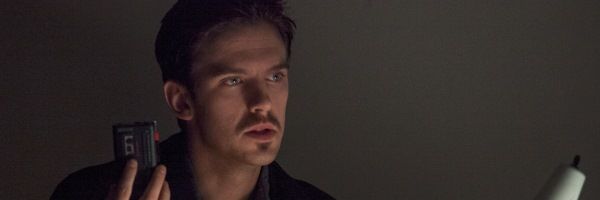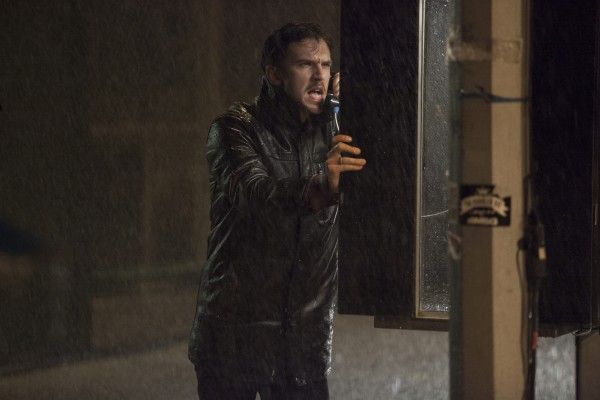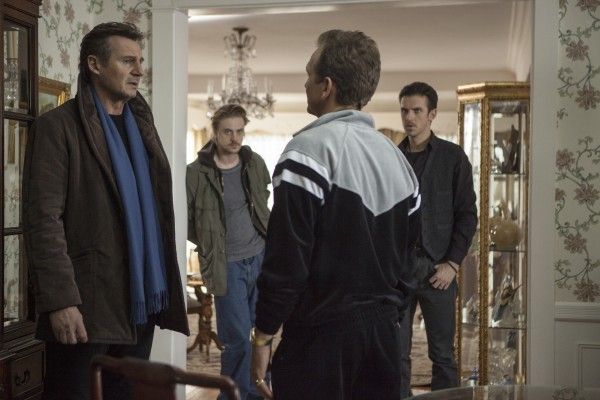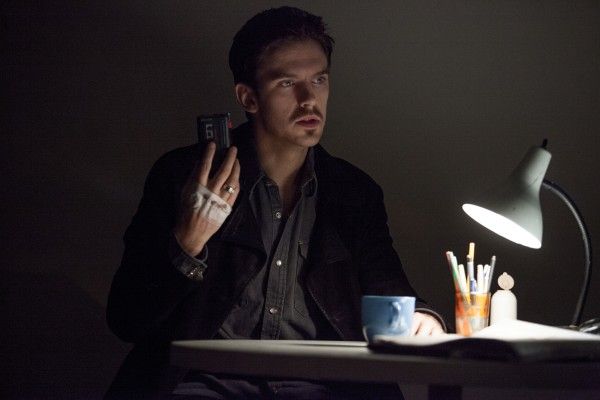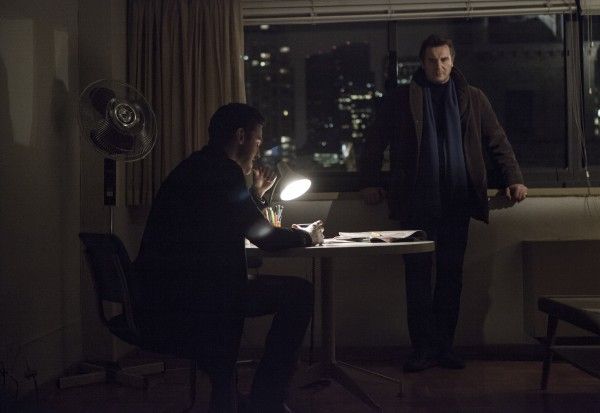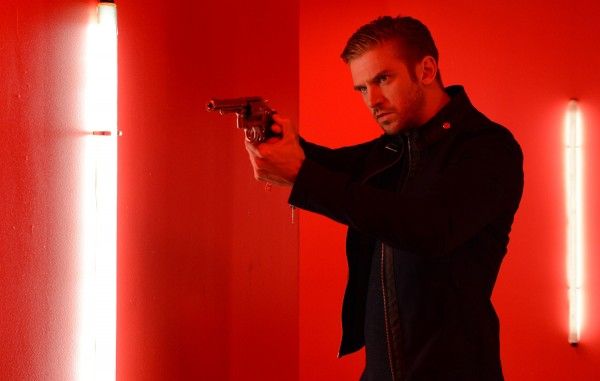It’s been two years since Dan Stevens departed Downton Abbey and he’s not lost any time actively pursuing some amazing new roles in theater, film and television. In his latest movie, A Walk Among the Tombstones, he stars opposite Liam Neeson playing a heroin trafficker bent on revenge who hires a private investigator (Neeson) to hunt down the serial killers (David Harbour, Adam David Thompson) that brutally murdered his wife. Opening September 19th, the crime drama also stars Boyd Holbrook, Brian “Astro” Bradley, Sebastian Roché, Mark Consuelos, and Ólafur Darri Ólafsson.
At the film’s recent press day, Stevens discussed why he finds it exciting to explore new and different roles, the challenge of transforming himself for each one, the appeal of playing a bad guy who’s a victim, his love of 70’s noirish thrillers like Klute, Dirty Harry, and The Conversation, his collaboration with director Scott Frank on the darkness of his character, how music helped him prepare for his role in The Guest, and what it’s been like working with his childhood heroes – Neeson, Ben Stiller, Adam Sandler and John Travolta -- on Tombstones, Night at the Museum: Secret of the Tomb, The Cobbler and Criminal Activities. Hit the jump to read the rest of the interview:
Question: You’ve been on a tear the last few years in terms of what you’ve done on Broadway and with films like The Guest, Night at the Museum: Secret of the Tomb, and now this. In what order did you do everything post Downton Abbey?
DAN STEVENS: Post Downton, I guess the first step was doing The Heiress on Broadway. When I made the decision to leave Downton, it was the beginning of that year. I didn’t know what was coming next, but the opportunity to do some theater in New York came up and I jumped at that. I’ve done a lot of theater in London. While I was doing The Heiress, Scott Frank, who directed A Walk Among the Tombstones, came and saw it. He was actively looking for someone a bit unexpected to play Kenny, a drug trafficker, and he didn’t want to go to whoever that go-to guy might be. I was actively looking to do some different things, and he literally sat in front of me and said, “I’ve never see you do something like this before and I’d love to see you try.” For a young actor, that’s about the most exciting thing that anyone can say to you. It’s just opening a door to step through and try some new things. That then led to having the confidence to go and sit in front of Adam Wingard who directed The Guest and say, “Look, I know I’m not your first choice for this, but I find your movie hilarious.” I loved You’re Next, and we shared a sense of humor, but also we shared a lot of the same kind of movies growing up. We were steeped in the same kind of cinematic vocabulary. So, there’s a great shorthand that develops there. And similarly, with Scott, I’d grown up loving those kinds of 70’s noirish thrillers – Klute, Dirty Harry, The Conversation. That was the kind of tone that he was looking to achieve in A Walk Among the Tombstones. I was very excited to explore something totally different. It was an interesting challenge.
I love how you transformed yourself for this film. It’s a great performance. I hardly recognized you. Can you talk about the appeal of the role and how you prepared?
STEVENS: Thank you. I’m pleased you didn’t recognize me. That’s sort of the point. The last couple of years have been a number of physical transformations and that aspect I hadn’t really been able to embrace before. It’s something that’s afforded you a lot more in film. You get the time to drop the weight, to bulk up again. I lost about 30 pounds to play Kenny in Tombstones, and then put about 25 back on to play David in The Guest. Then I put on 50 pounds of armor to play Lancelot in Night at the Museum. It’s been a number of quite physical challenges this year. That’s been really fun for me to surprise people a little bit and show up in some unexpected places and even put on a dress for High Maintenance. There have been some quite different images.
Usually, in these kinds of movies, the victim is a regular guy, an everyday man, but here you’re playing a character that could have been the villain in any other movie. What was it like playing a bad guy who’s a victim?
STEVENS: That was one of the really interesting things that Scott wanted to explore with the whole film but particularly with Kenny. When bad things happen to bad people, how does that make us feel? What happens to Kenny is deeply unpleasant, and I wouldn’t wish it on anybody. It’s the challenge of trying to evoke any kind of sympathy for a role that ordinarily we would say, “Oh, this is a bad guy” and dismiss him. To walk those sensibilities a little bit was the challenge of the film. All of the characters in this film have to one extent or another made a series of bad life choices that have ended them up in this dark place. And that’s the universe in which Tombstones takes place. It was really interesting to explore that.
Kenny doesn’t look like the typical drug dealer we see in most films. Your character is grieving and a lot of your performance is in your face and in the way you carry yourself. Was that in the script or did you bring that yourself?
STEVENS: I suppose the first thing to say is he’s a drug trafficker, not a drug dealer, which is an interesting distinction because it is within the underworld. It is a different status. He is clearly doing okay for himself living in that very nice mansion in Fort Greene. Within his role, he’s doing okay. But he’s made such a series of life choices that have ended him up in this situation. What happens to his wife is directly linked to his career choice ultimately. This is a man who’s facing up to those consequences. That’s quite a dark place to be to confront those consequences and the irreversible situation. It becomes for Kenny a very classic revenge trajectory. He pursues it to the bitter end, and at a certain point, leaves the path that Matt Scudder is on. Liam’s role is on a more redemptive path. But he has also made a series of bad choices in his life and is confronting those in his own way, as has Boyd Holbrook’s character, my brother. All of these characters are mixing in their poor choices which ferment into this underbelly of Brooklyn.
We can feel the weight on your shoulders as we watch your character.
STEVENS: Yeah. I’m the guy who has to outsource the revenge as well. He has to hire Scudder. He has to take this guy in, and there’s a certain kind of emasculation that that engenders. It’s a very tragic place to be, and when that happens to a character that we ordinarily just dismiss as a bad guy, it asks some very interesting moral questions which was part of the appeal of the script in the first place.
Did you work closely with Scott as far as developing your character? Also, did you ad lib or improvise anything?
STEVENS: I worked very closely with Scott. We didn’t have a huge amount of time, but he was interested to see first of all how I could transform myself, so the look was quite key, and exploring the darkness of it. I don’t think there was too much improv. Not that I can remember. But there may have been the odd line.
You mentioned you lost 30 pounds for this role and then you gained 25 pounds for The Guest. How do you do that? Do you work with a trainer?
STEVENS: I do. Certainly, for The Guest, I worked very closely with a trainer. I was in a nutritional program and all the rest. It was pretty intense. The physical preparation was a great part of the preparation for that role, just pushing myself to some quite insane lengths that I hadn’t had the opportunity to do before. It puts you in a different frame of mind, I have to say. I’m from a background of ‘if it hurts, stop.’ But I was encouraged to keep going and push through those pain boundaries and see what happened. It’s very rewarding seeing the physical transformation that I had. It’s quite interesting.
This has been a breakout year for you. What was it like working with Liam Neeson, John Travolta and Ben Stiller? Is it surreal for you?
STEVENS: At times, for sure. It’s been an amazing year actually just working with a number of my childhood heroes – Liam Neeson, Ben Stiller, Adam Sandler in The Cobbler, and John Travolta in Criminal Activities. Yeah, it is quite extraordinary, but what’s really exciting for me is just seeing how these guys work, especially on Tombstones. Liam leads a great set. He takes the work very seriously. He’s a total pro, shows up very cool, gets the job done. But also, I like his way of working. He has a lightness off camera which keeps everyone in the right place. It’s a very dark film, and if we were to inhabit that the whole time, it could be a lot tougher than it was. He’s a great guy to work with.
Leaving Downton gave you the opportunity to explore other roles and see what else was out there for you. Do you feel like you’re fulfilling that itch?
STEVENS: Yes, I’ve had a great couple of years exploring a fantastic range of roles. It’s not so much in reaction to Downton, but just connecting with something I always dreamed of doing, which was as an actor just getting to inhabit a number of different roles and surprise myself and surprise other people. It thrills me when people say, “Oh, I saw Tombstones and I had no idea it was Matthew from Downton.” That’s kind of the point. It was great.
Are you happy with what your tombstone from Downton Abbey says about you?
STEVENS: What does it say?
“Beloved Husband and Father.” What more could you want?
STEVENS: Well, there you go. That’s nice. Yes, I’m very happy with that.
Did you see the recent gaffe when a water bottle appeared on the mantle in the background of a photo promoting Downton Abbey? Did you get a laugh out of it?
STEVENS: I did. I’ve only just seen it, to be honest. I didn’t quite understand what happened, but it got left there by accident or something. It happens. It happens to other things as well.
Music plays a big part in The Guest. Did you listen to music to prepare for your character?
STEVENS: I do listen to a lot of music. Actually, I very often ask directors if they can offer up a play list. They very often have one anyway that they’re listening to. Adam is a huge music nut and he knows some really obscure bands and crazy things, and I always enjoy expanding my musical vocabulary as well as my film vocabulary. I always ask for a homework list of what movies a director has in mind when they’re thinking about this film, and I’ll go away and just broaden my cinematic vocabulary. Adam had one, and a number of tunes that actually end up in the movie were on his iPod on set. So, we were listening to them while I was preparing. I don’t know if you know the shot where it pans out the window, and it pans across and zooms in on David sitting very menacingly on the bed. That shot, that whole sequence, and that tune, he’d had planned out from the very beginning. He literally acted it out. He showed me the shot months before we got on to shooting that. It’s great when somebody is able to communicate an actual shot sequence to you and you know the world you’re inhabiting with that. It’s literally a haunting tune. Yes, music played a big part in that.
The last couple of years have been very busy for you. How do you balance having young children, moving from London to Brooklyn, and a personal life with your work schedule and does that play a factor in choosing roles?
STEVENS: Family is hugely important to me. Having kids is the best possible way to shake off any kind of darkness that might accompany a role that you’re playing. You step in that door and everything melts away very quickly, which is a good thing. I’m just enjoying exploring all manner of roles and traveling all over the country and seeing a lot more of the States than I had ever dreamed of, and taking them with me sometimes, which is cool. Showing the kids all different areas is great.

